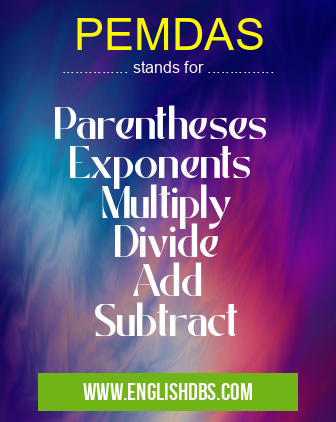What does PEMDAS mean in MATHEMATICS
PEMDAS is an acronym which stands for "Parentheses, Exponents, Multiply, Divide, Add and Subtract" and is used to remember the order of operations when solving math problems. Understanding this concept is essential for correctly completing mathematical equations and performing calculations accurately. In this article, I will explain in detail what each of these operations means and how to use this helpful acronym to help you answer math problems quickly and efficiently.

PEMDAS meaning in Mathematics in Academic & Science
PEMDAS mostly used in an acronym Mathematics in Category Academic & Science that means Parentheses Exponents Multiply Divide Add Subtract
Shorthand: PEMDAS,
Full Form: Parentheses
Exponents
Multiply
Divide
Add
Subtract
For more information of "Parentheses Exponents Multiply Divide Add Subtract", see the section below.
Parentheses
Parentheses are used to group numbers together so that you can solve the equation from within the parentheses first. For example, if you were presented with a problem like (2+3)x4=?, you would know that you needed to solve 2+3 first before multiplying it by 4 in order to get the correct answer. When using parentheses, be sure not to forget any numbers or operations inside them or your calculation will be wrong!
Exponents
Exponents are used when a number needs to be multiplied by itself a certain amount of times. For example, if you see an equation that says 4^2 = 16, then 4 would need to be multiplied by itself twice (in other words “squaredâ€). Exponents are written as a small number above and slightly right of another number — so in this case there would be a two on top of the four.
Multiplication
Multiplication is fairly straightforward; it simply involves multiplying two or more numbers together. For example 5 * 3 = 15 - five would need to be multiplied by three in order to obtain fifteen as the answer.
Division
Division is also fairly straightforward; it involves dividing one number by another number in order to obtain the answer. In other words, if we have 6/2 = 3 then six needs to be divided by two in order for us to get three as our answer.
Addition
Addition involves adding two or more numbers together in order to obtain an answer; for example 2+2=4 — two plus two needs to be added together in order for us to obtain four as our answer.
Subtraction
Subtraction is similar but instead involves subtracting one number from another; for example 10-5=5 — ten minus five equals five as our final answer.
Essential Questions and Answers on Parentheses Exponents Multiply Divide Add Subtract in "SCIENCE»MATH"
PEMDAS provides us with an easy way of remembering the order of operations when solving math problems which can help make tackling tricky equations much easier then trying guess your way through them! By using parentheses and exponents correctly, understanding multiplication and division processes, followed finally by addition & subtraction you should now have all the tools necessary for successfully taking on maths puzzles without any confusion!
